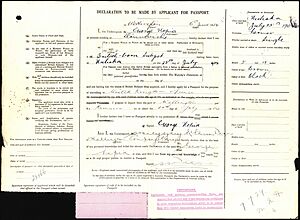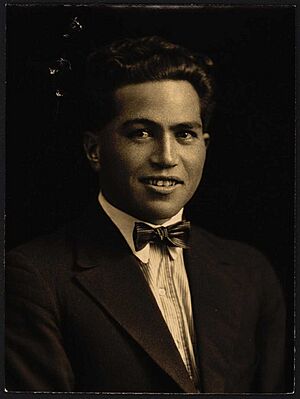George Nēpia facts for kids

George Nepia in 1935
|
|||||||||||||||||||||||||||||||||||||||||||||||||||||||||||||||||||||||||||||||||||||
| Birth name | George Nēpia | ||||||||||||||||||||||||||||||||||||||||||||||||||||||||||||||||||||||||||||||||||||
|---|---|---|---|---|---|---|---|---|---|---|---|---|---|---|---|---|---|---|---|---|---|---|---|---|---|---|---|---|---|---|---|---|---|---|---|---|---|---|---|---|---|---|---|---|---|---|---|---|---|---|---|---|---|---|---|---|---|---|---|---|---|---|---|---|---|---|---|---|---|---|---|---|---|---|---|---|---|---|---|---|---|---|---|---|---|
| Date of birth | 25 April 1905 | ||||||||||||||||||||||||||||||||||||||||||||||||||||||||||||||||||||||||||||||||||||
| Place of birth | Wairoa, Hawke's Bay Region, New Zealand | ||||||||||||||||||||||||||||||||||||||||||||||||||||||||||||||||||||||||||||||||||||
| Date of death | 27 June 1986 (aged 81) | ||||||||||||||||||||||||||||||||||||||||||||||||||||||||||||||||||||||||||||||||||||
| Height | 1.75 m (5 ft 9 in) | ||||||||||||||||||||||||||||||||||||||||||||||||||||||||||||||||||||||||||||||||||||
| Weight | 82 kg (12 st 13 lb) | ||||||||||||||||||||||||||||||||||||||||||||||||||||||||||||||||||||||||||||||||||||
| Rugby union career | |||||||||||||||||||||||||||||||||||||||||||||||||||||||||||||||||||||||||||||||||||||
|
|||||||||||||||||||||||||||||||||||||||||||||||||||||||||||||||||||||||||||||||||||||
|
Rugby league career
|
|||||||||||||||||||||||||||||||||||||||||||||||||||||||||||||||||||||||||||||||||||||
|
Playing information
|
|||||||||||||||||||||||||||||||||||||||||||||||||||||||||||||||||||||||||||||||||||||
| Position | Fullback | ||||||||||||||||||||||||||||||||||||||||||||||||||||||||||||||||||||||||||||||||||||
|
|||||||||||||||||||||||||||||||||||||||||||||||||||||||||||||||||||||||||||||||||||||
George Nēpia (Māori: Hōri Nēpia; 25 April 1905 – 27 August 1986) was a famous New Zealand Māori rugby player. He played both rugby union and rugby league. People remember him as an amazing full-back. He is one of the most famous Māori rugby players ever.
In 1990, George Nēpia was added to the New Zealand Sports Hall of Fame. This means he was one of the best sportspeople in New Zealand history. In 2004, he was chosen as one of "New Zealand's Top 100 History Makers" on a TV show. New Zealand Post even put him on postage stamps in 1990. A historian named Philippa Mein Smith called him "New Zealand rugby's first superstar".
Contents
Early Life and Family
George Nēpia was born in Wairoa, Hawkes Bay, New Zealand. His birth certificate says he was born in 1905. However, a passport application listed his birthday as July 25, 1904. Nēpia himself later said he was born in 1908. He claimed he made himself older to be allowed to try out for the All Blacks team in 1924. But rugby historians said this would mean he played top-level rugby at age 13, which was very unlikely. So, the earlier records are usually used.
After finishing primary school in Nūhaka, George's father wanted him to go to Te Aute College. But George chose to go to the nearby Maori Agricultural College instead. He said the rugby coach there offered to pay his school fees if he was good enough for the main rugby team.
In 1926, George Nēpia married Huinga Kōhere. They settled on Huinga's family farm in Rangitukia on the East Coast. They had four children: three sons and one daughter. Sadly, one of his sons, also named George, died at age 22 while serving in the army. He was a promising rugby player too.
Rugby Union Career
George Nēpia started playing for the Hawkes Bay provincial rugby team in 1922. At that time, Hawkes Bay had one of the strongest teams in New Zealand. They held the Ranfurly Shield, a famous rugby trophy, for 24 games in a row. They finally lost it in 1927. Nēpia first played on the wing, which is a position on the side of the field. Later, he moved to second-five eighth, a position in the middle of the field.
Becoming an Invincible All Black
In 1924, Nēpia was chosen to play full-back for the All Blacks team. This team went on a tour to the United Kingdom. Nēpia was one of the biggest stars of this tour. He played in all 32 games, which was very unusual, and scored 77 points. The team did not lose any matches during this tour. Because of this, they became known as The Invincibles. Before each game, Nēpia led the team in performing a haka, a traditional Māori dance. This haka was specially created for their tour.
George Nēpia was not chosen for the 1928 All Blacks tour to South Africa. Many people believe this was because of his race. Nēpia returned to play for the All Blacks in 1929 for tours to Australia. He also played against the British Lions in New Zealand in 1930. These were his last games for the All Blacks.
Rugby League Career
In 1935, George Nēpia went to England to play rugby league professionally. He first signed with the Streatham and Mitcham Rugby League Club in London. He was paid £500, which was the highest fee ever paid to a New Zealand rugby league player at that time. His family stayed in New Zealand.
At this time, rugby union was an amateur sport. This meant players could not be paid. Because Nēpia became a professional rugby league player, he was no longer allowed to play rugby union. Nēpia later moved to play for Halifax. In 1937, he came back to New Zealand. He played rugby league for Manukau. He also played for the New Zealand Māori and the New Zealand rugby league team. In July and August 1937, Nēpia traveled to the South Island. There, he played for both Hornby and the Canterbury teams.
Later Life and Legacy
After he stopped playing rugby, George Nēpia became a referee. He also worked as a farm manager in the Wairoa area. In 1975, his wife Huinga passed away. Nēpia spent his final years living with his son Winston in Rangitukia. He died in Ruatōria on 27 August 1986.
Tributes to George Nēpia
In 2011, a New Zealand writer named Hone Kouka wrote a play about George Nēpia. The play was called I, George Nēpia. Hone Kouka was Nēpia's great uncle. The play was timed to happen during the 2011 Rugby World Cup. Kouka said the play brought back "vivid memories of the rugby legend." It was also a chance to show the best of both rugby and New Zealand theater. Kouka talked to Nēpia's family before writing the play. They supported his project and trusted him. He remembered, "Opening night was scary, though. All the Nepias were in the audience. Thankfully they loved it." The play won four Chapman Tripp Theatre Awards in 2011.
Images for kids






